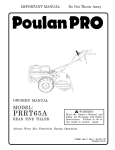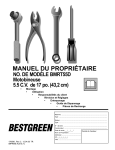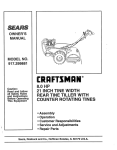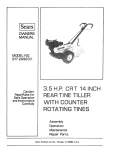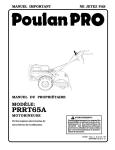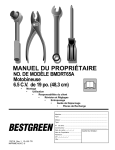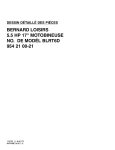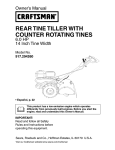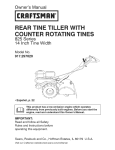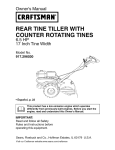Download Weed Eater WET6500A Owner`s manual
Transcript
OWNER'S MANUAL MODEL NO. WET6500A 6.5 HP 17 Inch Tiller • Assembly • Operation • Maintenance • Service and Adjustments • Storage • Troubleshooting • Repair Parts For Parts and Service, contact our authorized distributor: call 1-800-849-1297 For Technical Assistance: call 1-800-829-5886 ® 01029-weedeater 186100 Rev. 3 06.17.03 TR PRINTED IN U.S.A. SAFETY RULES Safe Operation Practices for Walk-Behind Powered Rotary Tillers TRAINING • • • • Read the Owner’s Manual carefully. Be thoroughly familiar with the controls and the proper use of the equipment. Know how to stop the unit and disengage the controls quickly. Never allow children to operate the equipment. Never allow adults to operate the equipment without proper instruction. Keep the area of operation clear of all persons, particularly small children, and pets. • • • • • • • PREPARATION • • • • • • • • • • Thoroughly inspect the area where the equipment is to be used and remove all foreign objects. Disengage all clutches and shift into neutral before starting the engine (motor). Do not operate the equipment without wearing adequate outer garments. Wear footwear that will improve footing on slippery surfaces. Handle fuel with care; it is highly flammable. Use an approved fuel container. Never add fuel to a running engine or hot engine. Fill fuel tank outdoors with extreme care. Never fill fuel tank indoors. Replace gasoline cap securely and clean up spilled fuel before restarting. Use extension cords and receptacles as specified by the manufacturer for all units with electric drive motors or electric starting motors. Never attempt to make any adjustments while the engine (motor) is running (except where specifically recommended by manufacturer). MAINTENANCE AND STORAGE • • • • • • • • • • • Keep machine, attachments, and accessories in safe working condition. Check shear pins, engine mounting bolts, and other bolts at frequent intervals for proper tightness to be sure the equipment is in safe working condition. Never store the machine with fuel in the fuel tank inside a building where ignition sources are present, such as hot water and space heaters, clothes dryers, and the like. Allow the engine to cool before storing in any enclosure. Always refer to the operator’s guide instructions for impor tant details if the tiller is to be stored for an extended period. - IMPORTANT CAUTIONS, IMPORTANTS, AND NOTES ARE A MEANS OF ATTRACTING ATTENTION TO IMPORTANT OR CRITICAL INFORMATION IN THIS MANUAL. IMPORTANT: USED TO ALERT YOU THAT THERE IS A POSSIBILITY OF DAMAGING THIS EQUIPMENT. OPERATION • • Never operate the tiller without proper guards, plates, or other safety protective devices in place. Keep children and pets away. Do not overload the machine capacity by attempting to till too deep at too fast a rate. Never operate the machine at high speeds on slippery surfaces. Look behind and use care when backing. Never allow bystanders near the unit. Use only attachments and accessories approved by the manufacturer of the tiller. Never operate the tiller without good visibility or light. Be careful when tilling in hard ground. The tines may catch in the ground and propel the tiller forward. If this occurs, let go of the handlebars and do not restrain the machine. Do not put hands or feet near or under rotating parts. Exercise extreme caution when operating on or crossing gravel drives, walks, or roads. Stay alert for hidden hazards or traffic. Do not carry passengers. After striking a foreign object, stop the engine (motor), remove the wire from the spark plug, thoroughly inspect the tiller for any damage, and repair the damage before restarting and operating the tiller. Exercise caution to avoid slipping or falling. If the unit should start to vibrate abnormally, stop the engine (motor) and check immediately for the cause. Vibration is generally a warning of trouble. Stop the engine (motor) when leaving the operating position. Take all possible precautions when leaving the machine unattended. Disengage the tines, shift into neutral, and stop the engine. Before cleaning, repairing, or inspecting, shut off the engine and make certain all moving parts have stopped. Disconnect the spark plug wire, and keep the wire away from the plug to prevent accidental starting. Disconnect the cord on electric motors. Do not run the engine indoors; exhaust fumes are dangerous. NOTE: Gives essential information that will aid you to better understand, incorporate, or execute a particular set of instructions. Look for this symbol to point out important safety precautions. It means CAUTION!!! BECOME ALERT!!! YOUR SAFETY IS INVOLVED. CAUTION: Always disconnect spark plug wire and place wire where it cannot contact spark plug in order to prevent accidental starting when setting up, transporting, adjusting or making repairs. WARNING The engine exhaust from this product contains chemicals known to the State of California to cause cancer, birth defects, or other reproductive harm. 2 PRODUCT SPECIFICATIONS Gasoline Capacity: 3 Quarts (2.8L) Unleaded Regular Oil (API-SF-SJ): (Capacity: 20 oz./0.6L) SAE 30 (Above 32°F/0°C) SAE 5w-30 (Below 32°F/0°C) Spark Plug : (Gap: .030"/0.76mm) Champion RN4C CUSTOMER RESPONSIBILITIES • • • Read and observe the safety rules. Follow a regular schedule in maintaining, caring for and using your tiller. Follow instructions under “Maintenance” and “Storage” sections of this Owner’s Manual. WARNING:This unit is equipped with an internal combustion engine and should not be used on or near any unimproved forest-covered, brush-covered or grass covered land unless the engine’s exhaust system is equipped with a spark arrester meeting applicable local or state laws (if any). If a spark arrester is used, it should be maintained in effective working order by the operator. In the state of California the above is required by law (Section 4442 of the California Public Resources Code). Other states may have similar laws. Federal laws apply on federal lands. See your Authorized Service Center/Department for spark arrester. Refer to the Repair Parts section of this manual for part number. CONGRATULATIONS on your purchase of a new tiller. It has been designed, engineered and manufactured to give you the best possible dependability and performance. Should you experience any problems you cannot easily remedy, please contact your nearest authorized service center. We have competent, well-trained technicians and the proper tools to service or repair this unit. Please read and retain this manual. The instructions will enable you to assemble and maintain your tiller properly. Always observe the “SAFETY RULES”. TABLE OF CONTENTS MAINTENANCE ..................................................... 12-14 SERVICE & ADJUSTMENTS ................................. 15-18 STORAGE .................................................................... 19 TROUBLESHOOTING ................................................. 20 REPAIR PARTS-TILLER......................................... 21-27 WARRANTY................................................................. 28 SAFETY RULES ............................................................ 2 CUSTOMER RESPONSIBILITIES................................. 3 PRODUCT SPECIFICATIONS ....................................... 3 ASSEMBLY ................................................................. 4-6 OPERATION ............................................................. 7-11 MAINTENANCE SCHEDULE ...................................... 12 3 ASSEMBLY Your new tiller has been assembled at the factory with exception of those parts left unassembled for shipping purposes. To ensure safe and proper operation of your tiller, all parts and hardware you assemble must be tightened securely. Use the correct tools as necessary to insure proper tightness. TOOLS REQUIRED FOR ASSEMBLY FRONT A socket wrench set will make assembly easier. Standard wrench sizes are listed. (1) Utility knife (1) Tire pressure gauge (1) Pair of pliers (1) 9/16" wrench LEFT RIGHT OPERATOR’S POSITION (See Fig. 1) When right or left hand is mentioned in this manual, it means when you are in the operating position (standing behind tiller handles). OPERATOR’S POSITION FIG. 1 CONTENTS OF HARDWARE PACK (1) Carriage Bolt 3/8-16 UNC x 1 Grade 5 (2) Handle Locks (1) Flat Washer 13/32 x 1 x 11 Gauge (1) Center Locknut 3/8-16 UNC (1) Handle Lock Lever (1) Pivot Bolt 3/8-16 UNC Grade 5 Extra Shear Pins & Clips 4 (1) Hairpin Clip ASSEMBLY • UNPACKING CARTON (See Fig. 2) CAUTION: Be careful of exposed staples when handling or disposing of cartoning material. Grasp handle assembly. Hold in “up” position. Be sure handle lock remains in gearcase notch. Slide handle assembly into position. HANDLE ASSEMBLY "UP" POSITION IMPORTANT: WHEN UNPACKING AND ASSEMBLING TILLER, BE CAREFUL NOT TO STRETCH OR KINK CABLES. • • • • • While holding handle assembly, cut cable ties securing handle assembly to top frame. Let handle assembly rest on tiller. Remove top frame of carton. Slowly ease handle assembly up and place on top of carton. Cut down right hand front and right hand rear corners of carton, lay side carton wall down. Remove packing material from handle assembly. TIGHTEN HANDLE LOCK LEVER TO HOLD LOOSEN HANDLE LOCK LEVER TO MOVE FIG. 4 HANDLE ASSEMBLY • • • • • SHIFT ROD • FIG. 2 • INSTALL HANDLE (See Figs. 3, 4, and 5) • • Insert one handle lock (with teeth facing outward) in gearcase notch. (Apply grease on smooth side of handle lock to aid in keeping lock in place until handle assembly is lowered into position.) Rotate handle assembly down. Insert rear carriage bolt first, with bolt head on L.H. side of tiller and loosely assemble locknut (See Fig. 5). Insert pivot bolt in front part of plate and tighten. Cut down remaining corners of carton and lay panels flat. Lower the handle assembly. Tighten nut on carriage bolt bolt so handle moves with some resistance. This will allow for easier adjustment. Place flat washer on threaded end of handle lock lever. Insert handle lock lever through handle base and gearcase. Screw in handle lock lever just enough to hold lever in place. Insert second handle lock (with teeth inward) in the slot of the handle base (just inside of washer). With handle assembly in lowest position, securely tighten handle lock lever by rotating clockwise. Leaving handle assembly in lowest position will make it easier to remove tiller from carton. HANDLE LOCK VIEWED FROM R.H. SIDE OF TILLER GEARCASE HANDLE ASSEMBLY GEARCASE NOTCH FLAT WASHER HANDLE LOCK LEVER SLOT HANDLE LOCK CARRIAGE BOLT PIVOT BOLT HANDLE BASE FIG. 3 LOCKNUTS FIG. 5 5 ASSEMBLY ATTACH CLUTCH CABLE (See Fig. 6) CONNECT SHIFT ROD (See Fig. 7) • • • Hook end of clutch cable through hole in control bar bracket if necessary. END OF CLUTCH CABLE Insert end of shift rod into hole of shift lever indicator. Insert hairpin clip through hole of shift rod to secure. SHIFT ROD CONTROL BAR BRACKET SHIFT LEVER INDICATOR HAIRPIN CLIP CONTROL BAR BRACKET CONTROL BAR FIG. 7 REMOVE TILLER FROM CRATE • CLUTCH CABLE • FIG. 6 • Make sure shift lever indicator is in “N” position (See Fig. 7) Tilt tiller forward by lifting handle. Separate cardboard cover from leveling shield. Rotate tiller handle to the right and pull tiller out of carton. CHECK TIRE PRESSURE The tires on your unit were overinflated at the factory for shipping purposes. Correct and equal tire pressure is important for best tilling performance. • Reduce tire pressure to 20 PSI (1.4 kg/cm2). HANDLE HEIGHT • 6 Handle height may be adjusted to better suit operator. (See “TO ADJUST HANDLE HEIGHT” in the Service and Adjustments section of this manual). OPERATION KNOW YOUR TILLER READ THIS OWNER'S MANUAL AND SAFETY RULES BEFORE OPERATING YOUR TILLER. Compare the illustrations with your tiller to familiarize yourself with the location of various controls and adjustments. Save this manual for future reference. These symbols may appear on your Tiller or in literature supplied with the product. Learn and understand their meaning. SHIFT LEVER THROTTLE CONTROL CHOKE CONTROL SHIFT LEVER INDICATOR DRIVE CONTROL BAR DEPTH STAKE LEVELING SHIELD RECOIL STARTER HANDLE OUTER SIDE SHIELD FIG. 8 MEETS ANSI SAFETY REQUIREMENTS Our tillers conform to the safety standards of the American National Standards Institute. THROTTLE CONTROL - Used to control engine speed. DRIVE CONTROL BAR - Used to engage tiller. DEPTH STAKE - Controls depth at which tiller will dig. LEVELING SHIELD - Levels tilled soil. OUTER SIDE SHIELD - Adjustable to protect small plants from being buried. SHIFT LEVER - Used to shift transmission gears. SHIFT LEVER INDICATOR - Shows which gear the transmission is in. RECOIL STARTER HANDLE - Used to start the engine. CHOKE CONTROL - Used when starting a cold engine. 7 OPERATION The operation of any tiller can result in foreign objects thrown into the eyes, which can result in severe eye damage. Always wear safety glasses or eye shields before starting your tiller and while tilling. We recommend a wide vision safety mask over spectacles or standard safety glasses. HARD TO SHIFT GEARS HOW TO USE YOUR TILLER Know how to operate all controls before adding fuel and oil or attempting to start engine. • STOPPING (See Fig. 9) DEPTH STAKE (See Fig. 10) The depth stake can be raised or lowered to allow you more versatile tilling and cultivating, or to more easily transport your tiller. TINES AND DRIVE • Release drive control bar to stop movement. • Move shift lever to “N” (neutral) position. ENGINE • Move throttle control to “STOP” position. If equipped with stop switch, move switch to “STOP” position. • Never use choke to stop engine. HANDLE Briefly engage drive control bar and release or rock tiller forward and backward until are able to shift gears. TRANSPORT POSITION SHALLOWEST TILLING (CULTIVATING) SHIFT LEVER DEEPEST TILLING THROTTLE CONTROL DEPTH STAKE FIG. 10 DRIVE CONTROL BAR “ENGAGED” POSITION TILLING (See Fig. 11) • DRIVE CONTROL BAR “DISENGAGED” POSITION • • • FIG. 9 TINE OPERATION - WITH WHEEL DRIVE • • Always release drive control bar before moving shift lever into another position. Tine movement is achieved by moving shift lever to ( ) till position and engaging drive control bar. Release depth stake pin. Pull the depth stake up for increased tilling depth. Place depth stake pin in hole of depth stake to lock in position. Place shift lever indicator in till position. Hold the drive control bar against the handle to start tilling movement. Tines and wheels will both turn. Move throttle control to “FAST” position for deep tilling. To cultivate, throttle control can be set at any desired speed, depending on how fast or slow you wish to cultivate. IMPORTANT: ALWAYS RELEASE DRIVE CONTROL BAR BEFORE MOVING SHIFT LEVER INTO ANOTHER POSITION. DEPTH STAKE PIN “RELEASED” POSITION FORWARD- WHEELS ONLY/TINES STOPPED • Release drive control bar and move shift lever indicator to “F” (forward) position. Engage drive control bar and tiller will move forward. REVERSE - WHEELS ONLY/TINES STOPPED • • • • • DO NOT STAND DIRECTLY BEHIND TILLER. Release the drive control bar. Move throttle control to “SLOW” position. Move shift lever indicator to “R” (reverse) position. Hold drive control bar against the handle to start tiller movement. “LOCKED” POSITION NUT “B” OUTER SIDE SHIELD NUT “A” FIG. 11 8 OPERATION TURNING • • • • • • • • Release the drive control bar. Move throttle control to “SLOW” position. Place shift lever indicator in “F” (forward) position. Tines will not turn. Lift handle to raise tines out of ground. Swing the handle in the opposite direction you wish to turn, being careful to keep feet and legs away from tines. When you have completed your turn-around, release the drive control bar and lower handle. Place shift lever in till position and move throttle control to desired speed. To begin tilling, hold drive control bar against the handle. • • Reinstall engine oil cap and tighten. For approximate capacity see “PRODUCT SPECIFICATIONS” on page 3 of this manual. All oil must meet A.P.I. Service Classification SF-SJ. For cold weather operation you should change oil for easier starting (See oil viscosity chart in the Maintenance section of this manual). To change engine oil, see the Maintenance section in this manual. OIL FILL CAP/DIPSTICK OUTER SIDE SHIELDS (See Fig. 11) The back edges of the outer side shields are slotted so that the shields can be raised for deep tilling and lowered for shallow tilling to protect small plants from being buried. Loosen nut “A” in slot and nut “B”. Move shield to desired position (both sides). Retighten nuts. FIG. 12 TO TRANSPORT ADD GASOLINE • CAUTION: Before lifting or transporting, allow tiller engine and muffler to cool. Disconnect spark plug wire. Drain gasoline from fuel tank. AROUND THE YARD • Release the depth stake pin. Move the depth stake down to the top hole for transporting the tiller. Place depth stake pin in hole of depth stake to lock in position. This prevents tines from scuffing the ground. • Place shift lever indicator in “F” (forward) position for transporting. • Hold the drive control bar against the handle to start tiller movement. Tines will not turn. • Move throttle control to desired speed. AROUND TOWN • Disconnect spark plug wire. • Drain fuel tank. • Transport in upright position to prevent oil leakage. CAUTION: Fill to within 1/2 inch of top of fuel tank to prevent spills and to allow for fuel expansion. If gasoline is accidentally spilled, move machine away from area of spill. Avoid creating any source of ignition until gasoline vapors have disappeared. Wipe off any spilled oil or fuel. Do not store, spill or use gasoline near an open flame. IMPORTANT: WHEN OPERATING IN TEMPERATURES BELOW32°F(0°C), USE FRESH, CLEAN WINTER GRADE GAS O LINE TO HELP INSURE GOOD COLD WEATHER STARTING. BEFORE STARTING ENGINE IMPORTANT: BE VERY CAREFUL NOT TO ALLOW DIRT TO ENTER THE ENGINE WHEN CHECKING OR ADDING OIL OR FUEL. USE CLEAN OIL AND FUEL AND STORE IN APPROVED, CLEAN, COVERED CONTAINERS. USE CLEAN FILL FUNNELS. CAUTION: Alcohol blended fuels (called gasohol or using ethanol or methanol) can attract moisture which leads to separation and formation of acids during storage. Acidic gas can damage the fuel system of an engine while in storage. To avoid engine problems, the fuel system should be emptied before storage of 30 days or longer. Drain the gas tank, start the engine and let it run until the fuel lines and carburetor are empty. Use fresh fuel next season. See Storage Instructions for additional information. Never use engine or carburetor cleaner products in the fuel tank or permanent damage may occur. CHECK ENGINE OIL LEVEL (See Fig. 12) • • • • Fill fuel tank to bottom of filler neck. Do not overfill. Use fresh, clean, regular unleaded gasoline with a minimum of 87 octane. (Use of leaded gasoline will increase carbon and lead oxide deposits and reduce valve life). Do not mix oil with gasoline. Purchase fuel in quantities that can be used within 30 days to assure fuel freshness. The engine in your unit has been shipped, from the factory, already filled with SAE 30 summer weight oil. Be sure tiller is level and the area around oil fill is clean. Check oil level before each use. Add oil if needed. Fill to full line on dipstick. To read proper level, tighten engine oil cap each time. 9 OPERATION TO START ENGINE (See Fig. 13) TILLING HINTS CAUTION: Keep drive control bar in “DISENGAGED” position when starting engine. CAUTION: Until you are accustomed to handling your tiller, start actual field use with throttle in slow position (mid-way between “FAST” and “IDLE”). When starting engine for the first time or if engine has run out of fuel, it will take extra pulls of the recoil starter to move fuel from the tank to the engine. • Make sure spark plug wire is properly connected. • Move shift lever indicator to “N” (neutral) position. • Place throttle control in “FAST” position. • To start a cold engine, push primer five (5) times before trying to start. Use a firm push. This step is not usually necessary when starting an engine which has already run for a few minutes. • Grasp recoil starter handle with one hand and grasp tiller handle with other hand. Pull rope out slowly until engine reaches start of compression cycle (rope will pull slightly harder at this point). • Pull recoil starter handle quickly. Do not let starter handle snap back against starter. • Allow engine to warm up for a few minutes before engaging tines. NOTE: In cooler weather it may be necessary to repeat priming steps. In warmer weather over priming may cause flooding and engine will not start. If you do flood engine, wait a few minutes before attempting to start and do not repeat priming steps. • • • • RECOIL STARTER HANDLE PRIMER Tilling is digging into, turning over, and breaking up packed soil before planting. Loose, unpacked soil helps root growth. Best tilling depth is 4" to 6" (10-15 cm). A tiller will also clear the soil of unwanted vegetation. The decomposition of this vegetable matter enriches the soil. Depending on the climate (rainfall and wind), it may be advisable to till the soil at the end of the growing season to further condition the soil. Soil conditions are important for proper tilling. Tines will not readily penetrate dry, hard soil which may contribute to excessive bounce and difficult handling of your tiller. Hard soil should be moistened before tilling; however, extremely wet soil will “ball-up” or clump during tilling. Wait until the soil is less wet in order to achieve the best results. When tilling in the fall, remove vines and long grass to prevent them from wrapping around the tine shaft and slowing your tilling operation. You will find tilling much easier if you leave a row untilled between passes. Then go back between tilled rows. (See Fig. 14) There are two reasons for doing this. First, wide turns are much easier to negotiate than about-faces. Second, the tiller won’t be pulling itself, and you, toward the row next to it. Do not lean on handle. This takes weight off the wheels and reduces traction. To get through a really tough section of sod or hard ground, apply upward pressure on handle or lower the depth stake. 3 4 2 1 FIG. 13 5 6 FIG. 14 10 7 OPERATION TINE SHEAR PINS ADJUST WHEELS FOR CULTIVATING (See Figs. 16 and 17) The tine assemblies on your tiller are secured to the tine shaft with shear pins (See “TINE REPLACEMENT” in the Service and Adjustments section of this manual). If the tiller is unusually overloaded or jammed, the shear pins are designed to break before internal damage occurs to the transmission. • If shear pin(s) break, replace only with those shown in the Repair Parts section of this manual. • Place blocks under right hand side of tiller and remove hairpin clip and clevis pin from right hand wheel. • Move wheel outward approximately 1 inch (2.5 cm) until hole in inner wheel hub lines up with inner hole in axle. • Replace clevis pin and hairpin clip on inside of wheel and remove blocks. • Repeat preceding steps on left hand side. NOTE: In extremely rough conditions and while cultivating, the wheels should be moved outward on the axle for increased stability. CULTIVATING Cultivating is destroying the weeds between rows to prevent them from robbing nourishment and moisture from the plants. At the same time, breaking up the upper layer of soil crust will help retain moisture in the soil. Best digging depth is 1" to 3" (2.5-7.5 cm). Lower the outer side shields to protect small plants from being buried. • Cultivate up and down the rows at a speed which will allow tines to uproot weeds and leave the ground in rough condition, promoting no further growth of weeds and grass (See Fig. 15). OUTER VIEW OF TIRE CLEVIS PIN HAIRPIN CLIP FIG. 16 FIG. 15 INNER VIEW OF TIRE CLEVIS PIN HAIRPIN CLIP FIG. 17 11 MAINTENANCE N YS EA SO OU RS RS 0H Y5 ER SERVICE DATES EV ER EV EV ER Y2 5H OU UR HO CH Y5 EA ER RE EV FO BE FILL IN DATES AS YOU COMPLETE REGULAR SERVICE S US E MAINTENANCE SCHEDULE Check Engine Oil Level Change Engine Oil 1,2 Oil Pivot Points Inspect Spark Arrester / Muffler Inspect Air Screen Clean or Replace Air Cleaner Cartridge 2 Clean Engine Cylinder Fins Replace Spark Plug RH Gear Case Grease Fitting (1oz.) 1 - Change more often when operating under a heavy load or in high ambient temperatures. 2 - Service more often when operating in dirty or dusty conditions. LUBRICATION CHART GENERAL RECOMMENDATIONS The warranty on this tiller does not cover items that have been subjected to operator abuse or negligence. To receive full value from the warranty, the operator must maintain tiller as instructed in this manual. Some adjustments will need to be made periodically to properly maintain your tiller. All adjustments in the Service and Adjustments section of this manual should be checked at least once each season. • Once a year you should replace the spark plug, clean or replace air filter, and check tines and belts for wear. A new spark plug and clean air filter assure proper air-fuel mixture and help your engine run better and last longer. c THROTTLE CONTROL d ENGINE eRH GEAR CASE GREASE FITTING c DEPTH STAKE PIN c LEVELING SHIELD HINGES c IDLER BEFORE EACH USE • • • BRACKET Check engine oil level. Check tine operation. Check for loose fasteners. c WHEEL HUB cSAE 30 OR 10W-30 MOTOR OIL dREFER TO MAINTENANCE “ENGINE” SECTION eEP #1 GREASE LUBRICATION Keep unit well lubricated (See “LUBRICATION CHART”). 12 MAINTENANCE Disconnect spark plug wire before performing any maintenance (except carburetor adjustment) to prevent accidental starting of engine. Prevent fires! Keep the engine free of grass, leaves, spilled oil, or fuel. Remove fuel from tank before tipping unit for maintenance. Clean muffler area of all grass, dirt, and debris. Do not touch hot muffler or cylinder fins as contact may cause burns. ENGINE LUBRICATION OIL DRAIN PLUG Use only high quality detergent oil rated with API service classification SF-SJ. Select the oil’s SAE viscosity grade according to your expected temperature. SAE VISCOSITY GRADES SAE 30 OIL LEVEL 5W-30 -20 F C -30 0 -20 30 -10 32 40 0 60 10 100 80 20 OIL FILLER PLUG 30 40 FIG. 19 TEMPERATURE RANGE ANTICIPATED BEFORE NEXT OIL CHANGE oil_visc_chart1_e FIG. 18 AIR FILTER (See Fig. 20) Your engine will not run properly using a dirty air filter. Clean the foam pre-cleaner after every 25 hours of operation or every season. Service paper cartridge every 100 hours of operation or every season, whichever occurs first. Service air cleaner more often under dusty conditions. • Remove cover screw and cover. NOTE: Although multi-viscosity oils (5W-30, 10W-30, etc.) improve starting in cold weather, these multi-viscosity oils will result in increased oil consumption when used above 32°F (0°C). Check your engine oil level more frequently to avoid possible engine damage from running low on oil. Change the oil after every 25 hours of operation or at least once a year if the tiller is not used for 25 hours in one year. Check the crankcase oil level before starting the engine and after each five (5) hours of continuous use. Add SAE 30 motor oil or equivalent. Tighten oil filler plug securely each time you check the oil level. TO SERVICE PRE-CLEANER • • • • • • • TO CHANGE ENGINE OIL (See Figs. 18 and 19) Determine temperature range expected before oil change. All oil must meet API service classification SF-SJ. • Be sure tiller is on level surface. • Oil will drain more freely when warm. • Use a funnel to prevent oil spill on tiller, and catch oil in a suitable container. • Remove drain plug. • Tip tiller forward to drain oil. • After oil has drained completely, replace oil drain plug and tighten securely. • Remove oil filler plug. Be careful not to allow dirt to enter the engine. • Refill engine with oil. See “CHECK ENGINE OIL LEVEL” in the Operation section of this manual. Remove foam pre-cleaner from air cleaner cover. Wash it in liquid detergent and water. Squeeze it dry in a clean cloth. Saturate it in engine oil. Wrap it in clean, absorbent cloth and squeeze to remove excess oil. If very dirty or damaged, replace pre-cleaner. Reinstall pre-cleaner into air cleaner cover. Reinstall cover and secure screw. TO SERVICE CARTRIDGE • • • Carefully remove cartridge to prevent debris from entering carburetor. Clean base carefully to prevent debris from entering carburetor. Clean cartridge by tapping gently on flat surface. If very dirty or damaged, replace cartridge. Reinstall cartridge, cover with pre-cleaner and secure with screw. IMPORTANT: PETROLEUM SOLVENTS, SUCH AS KEROSENE, ARE NOT TO BE USED TO CLEAN THE CARTRIDGE. THEY MAY CAUSE DETERIORATION OF THE CARTRIDGE. DO NOT OIL CARTRIDGE. DO NOT USE PRESSURIZED AIR TO CLEAN OR DRY CARTRIDGE. BASE FOAM PRECLEANER COVER COVER SCREW AIR CLEANER CARTRIDGE FIG. 20 13 MAINTENANCE COOLING SYSTEM (See Fig. 21) MUFFLER Your engine is air cooled. For proper engine performance and long life keep your engine clean. • Clean air screen frequently using a stiff-bristled brush. • Remove blower housing and clean as necessary. • Keep cylinder fins free of dirt and chaff. Do not operate tiller without muffler. Do not tamper with exhaust system. Damaged mufflers or spark arresters could create a fire hazard. Inspect periodically and replace if necessary. If your engine is equipped with a spark arrester screen assembly, remove every 50 hours for cleaning and inspection. Replace if damaged. SPARK PLUG CYLINDER FINS Replace spark plugs at the beginning of each tilling season or after every 50 hours of use, whichever comes first. Spark plug type and gap setting is shown in “PRODUCT SPECIFICATIONS” on page 3 of this manual. BLOWER HOUSING TRANSMISSION MUFFLER Once a season, lubricate the right hand side gear case grease fitting with oz. of EP #1 grease. AIR SCREEN CLEANING Do not clean your tiller when the engine and transmission are hot. We do not recommend using pressurized water (garden hose, etc.) to clean your unit unless the gasket area around the transmission and the engine muffler, air filter and carburetor are covered to keep water out. Water in engine will shorten the useful life of your tiller. • Clean engine, wheels, finish, etc. of all foreign matter. • Keep finished surfaces and wheels free of all gasoline, oil, etc. • Protect painted surfaces with automotive type wax. FIG. 21 14 SERVICE AND ADJUSTMENTS CAUTION: Disconnect spark plug wire from spark plug and place wire where it cannot come into contact with plug. TILLER TIRE CARE TO ADJUST HANDLE HEIGHT (See Fig. 22) CAUTION: When mounting tires, unless beads are seated, overinflation can cause an explosion. Select handle height best suited for your tilling conditions. Handle height will be different when tiller digs into soil. • First loosen handle lock lever. • Handle can be positioned at different settings between “HIGH” and “LOW” positions. • Retighten handle lock lever securely after adjusting. • • Maintain 20 PSI (1.4 kg/cm2) of tire pressure. If tire pressures are not equal, tiller will pull to one side. Keep tires free of gasoline or oil which can damage rubber. TO REMOVE WHEEL (See Fig. 23) HANDLE (HIGH POSITION) • • • • HANDLE LOCK LEVER Place blocks under transmission to keep tiller from tipping. Remove hairpin clip and clevis pin from wheel. Remove wheel and tire. Repair tire and reassemble. CLEVIS PIN HANDLE (LOW POSITION) FIG. 22 HAIRPIN CLIP FIG. 23 15 SERVICE AND ADJUSTMENTS TINE REPLACEMENT (See Figs. 24, 25 and 26) • CAUTION: Tines are sharp. Wear gloves or other protection when handling tines. • A badly worn tine causes your tiller to work harder and dig more shallow. Most important, worn tines cannot chop and shred organic matter as effectively nor bury it as deeply as good tines. A tine this worn needs to be replaced. NEW TINE To maintain the superb tilling performance of this machine the tines should be checked for sharpness, wear, and bending, particularly the tines which are next to the transmission. If the gap between the tines exceeds 3-1/2 inches (9 cm), they should be replaced or straightened as necessary. New tines should be assembled as shown in Fig. 28. Sharpened tine edges will rotate rearward from above. WORN TINE TINE TINE 3-1/2" MAX (9 CM) FIG. 24 FIG. 25 COUNTER TINE ROTATION 02 05 0 HAIRPIN CLIP SHARP EDGE SHARP EDGE SHARP EDGE SHARP EDGE SHARP EDGES SHEAR PIN SHARP EDGE FIG. 26 16 SERVICE AND ADJUSTMENTS TO REMOVE BELT GUARD (See Fig. 27) TO REPLACE GROUND DRIVE BELT (See Figs. 27 and 28) NOTE: For ease of removal, remove hairpin clip and clevis pin from left wheel. Pull wheel out from tiller about 1 inch (2.5 cm). • Remove two (2) screws from side of belt guard. • Remove hex nut and washer from bottom of belt guard (located behind wheel). • Pull belt guard out and away from unit. • Replace belt guard by reversing above procedure. • • • • • • BELT GUARD SCREW HEX NUT AND WASHER (LOCATED BEHIND TIRE) SCREW Remove belt guard as described in “TO REMOVE BELT GUARD”. Remove old belt by slipping off engine pulley first then remove from transmission pulley. Place new belt in groove of transmission pulley and into engine pulley. BELT MUST BE IN GROOVE ON TOP OF IDLER PULLEY. NOTE POSITION OF BELT TO GUIDES. Check belt adjustment as described below. Replace belt guard. Reposition wheel and replace clevis pin and hairpin clip. GROUND DRIVE BELT ADJUSTMENT (See Fig. 28) For proper belt tension, the extension spring should have about 5/8 inch (16 mm) stretch when drive control bar is in “ENGAGED” position. This tension can be attained as follows: • Loosen cable clip screw securing the drive control cable. • Slide cable forward for less tension and rearward for more tension until about 5/8 inch (16 mm) stretch is obtained while the drive control bar is engaged. • Tighten cable clip screw securely. HAIRPIN CLIP AND CLEVIS PIN FIG. 27 CABLE CLIP SCREW ENGINE PULLEY DRIVE CONTROL CABLE LESS TENSION 5/8" IDLER PULLEY TRANSMISSION PULLEY FIG. 28 17 EXTENSION SPRING MORE TENSION SERVICE AND ADJUSTMENTS ENGINE TO ADJUST THROTTLE CONTROL CABLE (See Fig. 29) The throttle control has been preset at the factory and adjustment should not be necessary. If adjustment is necessary, proceed as follows: • With engine not running, move remote throttle control lever to “FAST” position. • If throttle lever on engine touches high speed stop, no further adjustment is necessary. If throttle lever does not touch high speed stop, continue with adjustment procedure. • Loosen cable clamp screw. • Move throttle lever up until it touches high speed stop, and hold in this position. • Tighten cable clamp screw securely. HIGH SPEED STOP THROTTLE CABLE THROTTLE LEVER CABLE CLAMP SCREW FIG. 29 TO ADJUST CARBURETOR The carburetor has been preset at the factory and adjustment should not be necessary. However, engine performance can be affected by differences in fuel, temperature, altitude or load. If the carburetor does need adjustment, contact your nearest authorized service center/department IMPORTANT: NEVERTAMPER WITHTHE ENGINE GOVERNOR, WHICH IS FACTORY SET FOR PROPER ENGINE SPEED. OVERSPEEDING THE ENGINE ABOVE THE FACTORY HIGH SPEED SETTING CAN BE DANGEROUS. IF YOU THINK THE ENGINE-GOVERNED HIGH SPEED NEEDS ADJUSTING, CONTACT YOUR NEAREST AUTHORIZED SERVICE CENTER/ DEPARTMENT, WHICH HAS THE PROPER EQUIPMENT AND EXPERIENCE TO MAKE ANY NECESSARY ADJUSTMENTS. 18 STORAGE ENGINE OIL Immediately prepare your tiller for storage at the end of the season or if the unit will not be used for 30 days or more. Drain oil (with engine warm) and replace with clean oil. (See “ENGINE” in the Maintenance section of this manual). WARNING: Never store the tiller with gasoline in the tank inside a building where fumes may reach an open flame or spark. Allow the engine to cool before storing in any enclosure. CYLINDER(S) • • • TILLER • • • • • • Clean entire tiller (See “CLEANING” in the Maintenance section of this manual). Inspect and replace belts, if necessary (See belt replacement instructions in the Service and Adjustments section of this manual). Lubricate as shown in the Maintenance section of this manual. Be sure that all nuts, bolts and screws are securely fastened. Inspect moving parts for damage, breakage and wear. Replace if necessary. Touch up all rusted or chipped paint surfaces; sand lightly before painting. Remove spark plug. Pour 1 ounce (29 ml) of oil through spark plug hole into cylinder. Pull starter handle slowly several times to distribute oil. Replace with new spark plug. OTHER • • • • ENGINE Do not store gasoline from one season to another. Replace your gasoline can if your can starts to rust. Rust and/or dirt in your gasoline will cause problems. If possible, store your unit indoors and cover it to give protection from dust and dirt. Cover your unit with a suitable protective cover that does not retain moisture. Do not use plastic. Plastic cannot breathe which allows condensation to form and will cause your unit to rust. IMPORTANT: NEVER COVER TILLER WHILE ENGINE AND EXHAUST AREAS ARE STILL WARM. FUEL SYSTEM IMPORTANT: IT IS IMPORTANT TO PREVENT GUM DEPOSITS FROM FORMING IN ESSENTIAL FUEL SYSTEM PARTS SUCH AS THE CARBURETOR, FUEL FILTER, FUEL HOSE, OR TANK DURING STORAGE. ALSO, EXPERIENCE INDICATES THAT ALCOHOL BLENDED FUELS (CALLED GASOHOL OR USING ETHANOL OR METHANOL) CAN ATTRACT MOISTURE WHICH LEADS TO SEPARATION AND FORMATION OF ACIDS DURING STORAGE. ACIDIC GAS CAN DAMAGE THE FUEL SYSTEM OF AN ENGINE WHILE IN STORAGE. • • Drain the fuel tank. Start the engine and let it run until the fuel lines and carburetor are empty. • Never use engine or carburetor cleaner products in the fuel tank or permanent damage may occur. • Use fresh fuel next season. NOTE: Fuel stabilizer is an acceptable alternative in minimizing the formation of fuel gum deposits during storage. Add stabilizer to gasoline in fuel tank or storage container. Always follow the mix ratio found on stabilizer container. Run engine at least 10 minutes after adding stabilizer to allow the stabilizer to reach the carburetor. Do not drain the gas tank and carburetor if using fuel stabilizer. 19 TROUBLESHOOTING POINTS PROBLEM Will not start Hard to start Loss of power CAUSE CORRECTION 1. 2. 3. 4. 5. Out of fuel. Engine not “CHOKED” properly. Engine flooded. Dirty air cleaner. Water in fuel. 1. 2. 3. 4. 5. 6. 7. Clogged fuel tank. Loose spark plug wire. 6. 7. 8. 9. Bad spark plug or improper gap. Carburetor out of adjustment. 8. 9. 1. 2. 3. 4. 5. Throttle control not set properly. Dirty air cleaner. Bad spark plug or improper gap. Stale or dirty fuel. Loose spark plug wire. 1. 2. 3. 4. 5. 6. Carburetor out of adjustment. 6. 1. 2. 3. 4. 5. Engine is overloaded. Dirty air cleaner. Low oil level/dirty oil. Faulty spark plug. Oil in fuel. 1. 2. 3. 4. 5. 6. 7. Stale or dirty fuel. Water in fuel. 6. 7. 8. 9. 10. 11. 12. 13. Clogged fuel tank. Spark plug wire loose. Dirty engine air screen. Dirty/clogged muffler. Carburetor out of adjustment. Poor compression. 8. 9. 10. 11. 12. 13. Fill fuel tank. See “TO START ENGINE” in Operation section. Wait several minutes before attempting to start. Clean or replace air cleaner cartridge. Drain fuel tank and carburetor, and refill tank with fresh gasoline. Remove fuel tank and clean. Make sure spark plug wire is seated properly on plug. Replace spark plug or adjust gap. Make necessary adjustments. Place throttle control in “FAST” position. Clean or replace air cleaner cartridge. Replace spark plug or adjust gap. Drain fuel tank and refill with fresh gasoline. Make sure spark plug wire is seated properly on plug. Make necessary adjustments. Set depth stake for shallower tilling. Clean or replace air cleaner cartridge. Check oil level/change oil. Clean and regap or change spark plug. Drain and clean fuel tank and refill, and clean carburetor. Drain fuel tank and refill with fresh gasoline. Drain fuel tank and carburetor, and refill tank with fresh gasoline. Remove fuel tank and clean. Connect and tighten spark plug wire. Clean engine air screen. Clean/replace muffler. Make necessary adjustments. Contact an authorized service center/department. Engine overheats 1. 2. 3. 4. 5. Low oil level/dirty oil. Dirty engine air screen. Dirty engine. Partially plugged muffler. Improper carburetor adjustment. 1. 2. 3. 4. 5. Check oil level/change oil. Clean engine air screen. Clean cylinder fins, air screen, and muffler area. Remove and clean muffler. Adjust carburetor to richer position. Excessive bounce/ difficult handling 1. Ground too dry and hard. 1. Moisten ground or wait for more favorable soil conditions. Soil balls up or clumps 1. Ground too wet. 1. Wait for more favorable soil conditions. Engine runs but tiller won’t move 1. 2. 3. Drive control bar is not engaged. V-belt not correctly adjusted. V-belt is off pulley(s). 1. 2. 3. Engage drive control. Inspect/adjust V-belt. Inspect V-belt. Engine runs but labors when tilling 1. 2. 3. Tilling too deep. Throttle control not properly adjusted. Carburetor out of adjustment. 1. 2. 3. Set depth stake for shallower tilling. Check throttle control setting. Make necessary adjustments. Tines will not rotate 1. Shear pin(s) broken. 1. Replace shear pin(s). Hard to shift into gear 1. Gears not timed. 1. Briefly engage drive control bar and release or rock tiller forward and backward until are able to shift gears. Tiller shuts off when drive control bar engaged 1. Shift lever set in between counter rotating till position and forward rotating till position. Tines jammed. 1. Shift to either counter rotating till position or forward rotating till position. Clear tines. 2. 20 2. REPAIR PARTS TILLER - - MODEL NUMBER WET6500A HANDLE ASSEMBLY KEY NO. 1 2 4 8 10 11 15 16 17 18 19 20 21 PART NO. 175769 150744 159227 71191008 8389J 4497H 108281X 72110608 109229X 73680600 19131611 109228X 150217 DESCRIPTION Control, Throttle Grip, Handle Bar, Control Screw, Pan Hd. #10-24 Grip, Handle Clip, Hairpin Rod, Shift Bolt, Carriage 3/8-16 x 1 Gr. 5 Lock, Handle Nut Crownlock 3/8-16 Unc Washer 13/32 x 1 x 11 Ga. Lever, Lock, Handle Handle KEY NO. PART NO. DESCRIPTION 26 29 31 34 35 36 37 39 38 41 42 159232 73731000 150696 145821 146480 180456X550 102604X 10040500 73800500 72110514 121248X Cable, Clutch Nut, Keps #10-24 Unc Bolt, Pivot Bracket, Clutch Cable Grommet, Handle Bracket, Handle Grip, Bar Control Washer, Lock 5/16 Locknut 5/16-18 Bolt, Carriage 5/16-18 x 1-3/4 Bushing, Snap NOTE: All component dimensions given in U.S. inches. 1 inch = 25.4 mm 21 REPAIR PARTS TILLER - - MODEL NUMBER WET6500A MAINFRAME, LEFT SIDE KEY NO. PART NO. 1 2 3 4 5 6 7 8 9 73510500 10040600 73220600 170127 164329 110111X 72110404 8700J 86777 10 11 12 13 14 15 16 19 21 22 23 KEY NO. 24 25 26 27 28 29 30 31 32 33 34 35 36 37 38 39 40 44 65 DESCRIPTION Nut, Keps 5/16-18 Washer, Lock 3/8 Nut, Hex 3/8-16 Shield, Inner, Belt Guard Pin Spirol Flared Lever, Shift Bolt, Carriage 1/4-20 x 1/2 Gr. 5 Plate, Shift Indicator Screw, Hex, Washer Head, Slotted #10-24 x 1/2 9484R Clip 10040400 Washer, Lock 1/4 73220400 Nut, Hex 1/4-20 23230506 Screw, Set, Hex 5/16-18 x 3/8 156117 Spacer, Split 0.327 x 0.42 x 1.220 19111116 Washer 11/32 x 11/16 x 16 Ga. 145102 Sheave, Transmission 12000028 Ring, Retainer 110652X Spacer, Split 0.327 x 0.42 x 2.09 74770508 Bolt Hex 5/16-24 x 1/2 102190X Tire 183122X624 Rim 795R Tire Valve PART NO. 126875X 4497H 165501X550 132801 104679X 12000032 159229 102384X 102141X 74760616 102383X 74760524 102331X 130812 74760544 140062 170488 73800500 73970500 DESCRIPTION Rivet, Drilled Clip, Hairpin Guard, Belt Belt, V Pulley, Idler Ring, Klip Bracket, Idler Bolt, Hex 5/16-16 x 12 Shaft, Idler Arm Bolt, Hex 3/8-16 x 1 Counterweight, L. H. Bolt, Hex 5/16-18 x 1-1/2 Bracket, Reinforcement, L. H. Sheave, Engine Bolt, Hex 5/16-18 x 2-3/4 Cap, Plunger Screw, Hex Wsh Slt #10-24 x .50 Nut, Lock 5/16-18 Nut, Lock Hex Flange NOTE: All component dimensions given in U.S. inches. 1 inch = 25.4 mm 22 REPAIR PARTS TILLER - - MODEL NUMBER WET6500A MAINFRAME, RIGHT SIDE 15 14 13 12 5 10 7 8 11 KEY NO. PART NO. DESCRIPTION 5 7 8 9 10 11 12 102332X 102173X 10040600 73220600 74760524 4497H 126875X Bracket, Reinforcement Counter Weight, R.H. Washer, Lock 3/8 Nut, Hex 3/8-16 Bolt, Hex 5/16-18 x 1-1/2 Clip, Hairpin Rivet, Drilled 9 KEY NO. PART NO. 13 102190X 183122X624 795R 73970500 ------- 14 15 DESCRIPTION Tire Rim Tire Valve Nut, Hex Flange Engine, Tec Model No. OHH65 (Order parts from engine Manufacturer) NOTE: All component dimensions given in U.S. inches. 1 inch = 25.4 mm 23 REPAIR PARTS TILLER - - MODEL NUMBER WET6500A TRANSMISSION 12 9 13 15 11 60 10 16 48 9 14 8 5 7 6 4 23 21 22 5 18 29 30 19 3 18 18 34 40 18 2 44 31 20 27 25 24 18 28 32 42 41 33 38 37 43 53 37 39 49 35 36 50 52 25 24 53 44 transmission_1.95b KEY NO. PART NO. 1 180677 2 180627 3 4 5 6 7 8 9 10 11 12 13 14 15 16 18 19 20 161963 5020J 1370H 137335 145101 4895H 154467 7392M 100371K 106160X 142145 8353J 12000039 154466 4358J 12000040 102114X 21 22 23 24 25 27 28 102115X 6803J 102111X 10040700 73610700 143009 106390X 51 58 DESCRIPTION KEY NO. PART NO. 29 30 31 32 33 34 35 36 102134X 150737 143008 106388X 102121X 102112X 102101X 154355 DESCRIPTION Chain #35-50 Pitch Ground Shaft Assembly Bearing, Shaft, Ground Drive Spacer 0.70 x 1.00 x 1.150 Sprocket and Gear Assembly Shaft, Reduction (2nd) Screw, Whiz, Lock 5/16-18 x 3-1/2 Sprocket Assembly w/Bearing (Includes Key Nos. 37 and 38) 37 4422J Bearing, Needle 38 154356 Sprocket, Tine 39 105345X Gear, Cluster, Red 1st & 2nd 40 105346X Gear, Reverse 41 8358J Shaft, Reduction (1st) 42 4220R Washer, Thrust 43 106146X Spacer 1.01 x 1.75 x 0.760 44 155236 Seal Asm, Oil 48 180631 Gearcase, R.H. w/Bearing (Includes Key No. 8) 49 132688 Shaft, Tine 50 106147X Chain, Roller #50-50 Pitch 51 17720408 Screw 1/4-20 x 1/2 52 73220500 Nut, Hex 5/16-18 53 165140 Kit, Bearing, Tine Shaft 58 179520 Bolt Shoulder 1/4-20 Unc x .875 60 6855M Fitting Grease -6066J Grease, Plastilube #1 NOTE: All component dimensions given in U.S. inches. 1 inch = 25.4 mm Transmission Assembly (Includes Key Nos. 2-53) Gearcase, L.H. w/Bearing (Includes Key No. 4) Gasket, Gearcase Bearing, Needle Washer, Thrust 5/8 x 1.10 x 1/32 Pinion, Input Shaft, Input Bearing, Needle Washer, Seal Ball, Steel Spring, Shift, Fork O-Ring Arm,. Shift Fork, Shift Ring, Klip Shaft, Shift Washer Ring, Klip Gear, Assembly, Reverse Idler (Includes Key Nos. 21 and 22) Gear, Reverse Idler Bearing, Needle Shaft, Reverse Idler Washer, Lock 7/16 Nut, Hex 7/16-20 Bearing, Shaft, Ground Drive Spacer 0.765 x 1.125 x 1.23 24 REPAIR PARTS TILLER - - MODEL NUMBER WET6500A TINE SHIELD 4 3 5 6 7 1 8 14 13 2 29 5 9 18 28 12 11 14 10 12 11 23 24 25 23 27 11 33 32 12 1 11 24 29 22 21 16 12 11 16 5 23 26 12 20 19 15 tine_shield_13_in(sears) KEY NO. 1 2 3 4 5 6 7 8 9 10 11 12 13 14 15 16 PART NO. 73900500 161415X550 8393J 12000035 180847 8394J 8392J 109230X 102326X550 72140508 73220500 10040500 72110510 124343X 161414X550 73900400 KEY NO. DESCRIPTION Nut, Flange 5/16-18 Shield, Side, Outer L. H. Pin, Stake, Depth Ring, Klip Bolt, Carriage 5/16-18 x 3/4 Spring Bracket, Latch Spring, Depth Stake Shield, Tine Bolt 5/16-18 x 1 Nut, Hex 5/16-18 Washer, Lock 5/16 Bolt, Carriage 5/16-18 x 1-1/4 Bracket, Shield Tine Shield, Side, Outer R.H. Nut, Hex Flange 1/4-20 Unc PART NO. DESCRIPTION 18 72040410 Bolt, Carriage 1/4-20 x 1-1/4 Gr. 5 19 102701X Grip 20 73220600 Nut, Hex 3/8-16 21 102156X Stake, Depth 22 74930632 Bolt, Hex 3/8-16 x 2 23 4440J Hinge 24 72140404 Bolt, Carriage 1/4-20 x 1/2 Gr. 5 25 6712J Cap, Vinyl 26 109227X Pad, Idler 27 102695X550 Shield, Leveling 28 120588X Pin, Hinge 29 104085X550 Shield, Side 32 73220400 Nut Fin Hex 1/4-20 Unc 33 10040400 Washer Lock Hvy Helical 1/4 NOTE: All component dimensions given in U.S. inches. 1 inch = 25.4 mm 25 REPAIR PARTS TILLER - - MODEL NUMBER WET6500A TINE ASSEMBLY 2 1 1 1 3 5 6 7 1 4 3 11 2 11 9 8 9 10 9 4 9 tine_ipb_1 KEY NO. PART NO. DESCRIPTION 1 2 3 4 5 6 7 4459J 132673 6554J 3146R 132727 73610600 10040600 Tine, Outer, L.H. Clevis Pin Tine, Inner, L.H. Clip, Hairpin Assembly, Hub and Plate, L.H. Nut, Hex 3/8-24 Washer, Lock 3/8 KEY NO. PART NO. DESCRIPTION 8 9 10 11 74610616 4460J 132728 6555J Bolt, Hex 3/8-24 x 1 Tine, Outer, R.H. Assembly, Hub and Plate, R.H. Tine, Inner, R.H. NOTE: All component dimensions given in U.S. inches. 1 inch = 25.4 mm 26 REPAIR PARTS TILLER - - MODEL NUMBER WET6500A DECALS 1 3 4 10 6 5 12 9 KEY NO. 1 3 4 5 6 9 10 12 --- PART NO. 162846 186761 143678 141907 102180X 141906 156199 162215 186100 186101 DESCRIPTION Decal, Logo Decal, Logo Decal, Instruction, Tilling Decal, Hand Placement Decal, Shift Indicator Decal, Warning, Rotating Tines Deal, Reverse Decal, Tine Shield Wrng Dom Manual, Owner's (English) Manual, Owner's (Spanish) 27 LIMITED WARRANTY The Manufacturer warrants to the original consumer purchaser that this product as manufactured is free from defects in materials and workmanship. For a period of two (2) years from date of purchase by the original consumer purchaser, we will repair or replace, at our option, without charge for parts or labor incurred in replacing parts, any part which we find to be defective due to materials or workmanship. This Warranty is subject to the following limitations and exclusions. 1. This warranty does not apply to the engine or components parts thereof. Please refer to the applicable manufacturer's warranty on these items. 2. Transportation charges for the movement of any power equipment unit or attachment are the responsibility of the purchaser. Transportation charges for any parts submitted for replacement under this warranty must be paid by the purchaser unless such return is requested by Electrolux Home Products. 3. The Warranty period for any products used for rental or commercial purposes is limited to 90 days from the date of original purchase. 4. This Warranty applies only to products which have been properly assembled, adjusted, operated, and maintained in accordance with the instructions furnished. This Warranty does not apply to any product which has been subjected to alteration, misuse, abuse, improper assembly or installation, delivery damage, or to normal wear of the product. 5. Exclusions: Excluded from this Warranty are belts, tines, tine adapters, normal wear, normal adjustments, standard hardware and normal maintenance. 6. In the event you have a claim under this Warranty, you must return the product to an authorized service dealer. Should you have any unanswered questions concerning this Warranty, please contact: Electrolux Home Products, Inc. Outdoor Products Customer Service Dept. 250 Bobby Jones Expressway Augusta, GA 30909 USA In Canada contact: Electrolux Canada Corp. 7075 Ordan Drive Mississauga, Ontario L5T 1K6 giving the model number, serial number and date of purchase of your product and the name and address of the authorized dealer from whom it was purchased. THIS WARRANTY DOES NOT APPLY TO INCIDENTAL OR CONSEQUENTIAL DAMAGES AND ANY IMPLIED WARRANTIES ARE LIMITED TO THE SAME TIME PERIODS STATED HEREIN FOR OUR EXPRESSED WARRANTIES. Some areas do not allow the limitation of consequential damages or limitations of how long an implied Warranty may last, so the above limitations or exclusions may not apply to you. This Warranty gives you specific legal rights, and you may have other rights which vary from locale to locale. This is a limited Warranty within the meaning of that term as defined in the Magnuson-Moss Act of 1975. ® 01029-weedeater




























